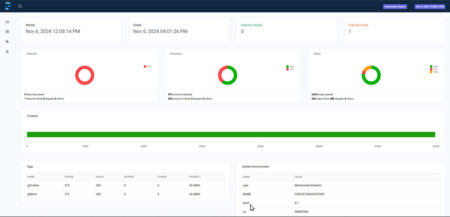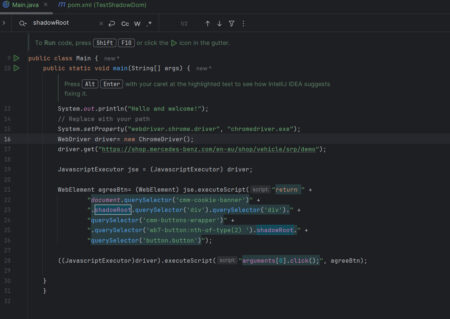In our connected world, APIs are important for many applications. They allow simple websites and complex systems to work well. To make sure our applications are strong and reliable, we need to test these APIs properly, including services like OpenCage. This ensures they function correctly. This is where Bruno comes in! Whether you want to
The post Comprehensive Bruno Tutorial for API Testing appeared first on Codoid.
Software Engineering
The blog discusses how Natural Language Processing (NLP) transforms insurance fraud detection by analyzing vast amounts of text data to identify fraudulent patterns and anomalies. Techniques like entity recognition and sentiment analysis enable insurers to detect inconsistencies in claim submissions, enhancing fraud prevention accuracy and efficiency. NLP automates data extraction, reduces manual effort, and triggers real-time alerts, enabling timely responses to fraud.
The post The Role of NLP in Insurance Fraud Detection and Prevention first appeared on TestingXperts.
The topic of artificial intelligence (AI) and the idea of AI has become very popular in recent years. Machines now behave like people and can sometimes think better than us, especially when it comes to driverless cars. This technology is no longer just in stories or movies. It is part of our daily lives, affects
The post The Benefits and Risks of AI appeared first on Codoid.
This blog explains why compliance testing is important in eLearning. It shows how compliance testing makes sure your eLearning courses follow industry standards. This testing is essential for a good learning experience for all learners. We will cover the testing process, key tools, and best practices. These points will help you understand more about compliance
The post Compliance Testing in eLearning appeared first on Codoid.
In today’s world of finance, mobile applications for test trading software are essential tools for users who need quick access to real-time data and market analysis within a reliable Electronic trading platform, including algorithmic trading capabilities, alongside vast amounts of data for portfolio management tools. As more investors, traders, and researchers rely on these apps
The post Comprehensive Strategies to Test Trading Software appeared first on Codoid.
The blog discusses the critical role of quality assurance (QA) in migrating to the ISO 20022 standard, which is essential for modernizing global financial messaging. With enhanced data quality, interoperability, and compliance, ISO 20022 improves cross-border payment processing. Tx offers customized QA solutions, including functional testing, data validation, risk assessment, and security audits, to ensure a seamless, compliant transition for financial institutions.
The post Role of QA in the Ramification of ISO 20022 Transformation first appeared on TestingXperts.
A majority of our users are on mobile safari, but we run our automation in pipelines using a linux kernal. Is there a way a good option for running our tests in webkit-based browser to ensure it renders correctly on Safari (or as best we can)? I’ve seen webkitgtk, and I did find some driver documentation on it, but I don’t know anything about it AT ALL, other than it exists. Thanks!
AI coding assistants like Cursor AI and GitHub Copilot are changing the way we create software. These powerful tools help developers write better code by providing advanced code completion and intelligent suggestions. In this comparison, we’ll take a closer look at what each tool offers, along with their strengths and weaknesses. By understanding the differences
The post Cursor AI vs Copilot: A Detailed Analysis appeared first on Codoid.
What is the best test approach for blackbox/functional testing when there is very less time to test and feature has to go live in production next day.
without leaving out important test scenarios or making mistakes in testing?
i have written this code in which i am able to get the Shadow element. package org.example; import org.openqa.selenium.JavascriptExecutor; import org.openqa.selenium.WebDriver; import org.openqa.selenium.WebElement; import org.openqa.selenium.chrome.ChromeDriver; public class Main { public static void main(String[] args) { System.out.println(“Hello and welcome!”); System.setProperty(“webdriver.chrome.driver”, “chromedriver.exe”); WebDriver driver= new ChromeDriver(); driver.get(“https://shop.mercedes-benz.com/en-au/shop/vehicle/srp/demo”); JavascriptExecutor jse = (JavascriptExecutor) driver; WebElement agreeBtn= (WebElement) jse.executeScript(“return document.querySelector(‘cmm-cookie-banner’).shadowRoot.querySelector(‘div’).querySelector(‘div’).querySelector(‘cmm-buttons-wrapper’).querySelector(‘wb7-button:nth-of-type(2) ‘).shadowRoot.querySelector(‘button.button’)”); ((JavascriptExecutor)driver).executeScript(“arguments[0].click();”, agreeBtn); } } the below is the output when i run this program:Nov 05, 2024 10:03:15 PM org.openqa.selenium.devtools.CdpVersionFinder findNearestMatch WARNING: Unable to find an exact match for CDP version 130, returning the closest version; found: 129; Please update to a Selenium version that supports CDP version 130 Exception in thread “main” org.openqa.selenium.JavascriptException: javascript error: Cannot read properties of null (reading ‘shadowRoot’) (Session info: chrome=130.0.6723.92) Build info: version: ‘4.25.0’, revision: ‘030fcf7918’ System info: os.name: ‘Windows 11’, os.arch: ‘amd64’, os.version: ‘10.0’, java.version: ‘17.0.8’ Driver info: org.openqa.selenium.chrome.ChromeDriver Command: [647d6b65e33549f28a4ea4e137e0a4f5, executeScript {script=return document.querySelector(‘cmm-cookie-banner’).shadowRoot.querySelector(‘div’).querySelector(‘div’).querySelector(‘cmm-buttons-wrapper’).querySelector(‘wb7-button:nth-of-type(2) ‘).shadowRoot.querySelector(‘button.button’), args=[]}] Capabilities {acceptInsecureCerts: false, browserName: chrome, browserVersion: 130.0.6723.92, chrome: {chromedriverVersion: 129.0.6668.9 (ab04602ab643c…, userDataDir: C:UsersusAppDataLocalT…}, fedcm:accounts: true, goog:chromeOptions: {debuggerAddress: localhost:54013}, networkConnectionEnabled: false, pageLoadStrategy: normal, platformName: windows, proxy: Proxy(), se:cdp: ws://localhost:54013/devtoo…, se:cdpVersion: 130.0.6723.92, setWindowRect: true, strictFileInteractability: false, timeouts: {implicit: 0, pageLoad: 300000, script: 30000}, unhandledPromptBehavior: dismiss and notify, webauthn:extension:credBlob: true, webauthn:extension:largeBlob: true, webauthn:extension:minPinLength: true, webauthn:extension:prf: true, webauthn:virtualAuthenticators: true} Session ID: 647d6b65e33549f28a4ea4e137e0a4f5 at java.base/jdk.internal.reflect.NativeConstructorAccessorImpl.newInstance0(Native Method) at java.base/jdk.internal.reflect.NativeConstructorAccessorImpl.newInstance(NativeConstructorAccessorImpl.java:77) at java.base/jdk.internal.reflect.DelegatingConstructorAccessorImpl.newInstance(DelegatingConstructorAccessorImpl.java:45) at java.base/java.lang.reflect.Constructor.newInstanceWithCaller(Constructor.java:499) at java.base/java.lang.reflect.Constructor.newInstance(Constructor.java:480) at org.openqa.selenium.remote.ErrorCodec.decode(ErrorCodec.java:167) at org.openqa.selenium.remote.codec.w3c.W3CHttpResponseCodec.decode(W3CHttpResponseCodec.java:138) at org.openqa.selenium.remote.codec.w3c.W3CHttpResponseCodec.decode(W3CHttpResponseCodec.java:50) at org.openqa.selenium.remote.HttpCommandExecutor.execute(HttpCommandExecutor.java:190) at org.openqa.selenium.remote.service.DriverCommandExecutor.invokeExecute(DriverCommandExecutor.java:216) at org.openqa.selenium.remote.service.DriverCommandExecutor.execute(DriverCommandExecutor.java:174) at org.openqa.selenium.remote.RemoteWebDriver.execute(RemoteWebDriver.java:545) at org.openqa.selenium.remote.RemoteWebDriver.executeScript(RemoteWebDriver.java:476) at org.example.Main.main(Main.java:20)
Process finished with exit code 1 Also, when i check for the dom element into browser, i am able to locate.: PFA the image as well. Can you please advise how can i resolve this? I am really in need to solve this. I will be obliged of your help. Thanks
In today’s gaming world, giving players a great experience is very important. Game testing is a key part of making sure video games are high quality and work well. It helps find and fix bugs, glitches, and performance issues. The goal is to ensure players have a fun and smooth time. This article looks at
The post Overcoming Challenges in Game Testing appeared first on Codoid.
The blog discusses how cloud-managed services offer a strategic solution for businesses aiming to streamline IT processes, enhance security, and reduce costs. These services, managed by third-party providers, provide cost savings, cybersecurity, disaster recovery, and scalability. Essential best practices, including phased cloud migration and efficient cost management, help maximize the benefits.
The post Why Businesses Should Shift to Cloud Managed Services  first appeared on TestingXperts.
In today’s quick software development world, it is important to keep apps high quality. A key part of this is software testing. Tosca automation is a strong tool that helps with this task. This blog, titled “Tosca Automation Tutorial: Model-Based Approach,†will cover the main points about Tosca. We will look into its new model-based
The post Tosca Automation Tutorial: Model-Based Approach appeared first on Codoid.
I have below code and it will dynamically inject optionName to a xpath.
And try to click on it.
getSortOptionByName(optionName: string) {
return $(`//android.widget.Button[@content-desc=”${optionName}”]`);
}
Below is the full code.
public async selectingEachSortOption(): Promise<void>
{
const sortOptions = await this.getAllTheAvailableSortOptions();
for(const sortItem of sortOptions){
await (await this.getSortOptionByName(sortItem)).waitForDisplayed({ timeout: 5000 });
await (await this.getSortOptionByName(sortItem)).waitForEnabled({ timeout: 5000 });
await (await this.getSortOptionByName(sortItem)).click();
this.clickOnSortByDropDown();
}
}
When I use this code in my test, It will iterate through the 1st loop.(I have 4 loops)
But at the 2nd loop, it will end with no errors and the test will mark as pass.
What are the possible mistakes I’m doing here?
Data breaches can cost organizations millions in direct damages, lost business and legal fees. But beyond those immediate costs, breaches damage trust, leading to long-term revenue losses. An effective SaaS application security testing mitigates these risks, increasing the bottom line. Read to know more!
The post From Compliance to Competitive Advantage: How SaaS Application Security Testing Boosts Market Position first appeared on TestingXperts.
> #shadow-root (open)
> …
> …
> …
> …
Mercedes-Benz Australia/Pacific Pty Ltd uses cookies for various purposesWe, Mercedes-Benz Australia/Pacific Pty Ltd and Mercedes-Benz AG, do this so that we can make our webpages more user-friendly, continuously improve them, and show offers and advertisements that are suited to you. We work with selected partners (including Google, Facebook and Salesforce) to show you user-based content and advertising on this website and other websites. In addition, we share the data collected on the website with other Mercedes-Benz AG Group companies (i.e., Mercedes-AMG GmbH) and Mercedes-Benz Mobility AG, so that they can improve their own offers and show you advertising tailored to you.
You can revoke your consent at any time. To manage your preferences and consents or for further information (including data transmissions) please refer to our Cookie Policy and our Privacy Policy.Important: If you have already provided Mercedes-Benz Australia/Pacific Pty Ltd (MBAuP) with personally identifiable information, by clicking “Agree to all†you consent to MBAuP combining the personally identifiable information that MBAuP already possesses with your browsing activity including on non MBAuP websites.Cookie Policy – Manage Preferences
Agree to all
Privacy Policy
Select allTechnically requiredRequired web technologies and cookies make our website technically accessible to and usable for you. This applies to fundamental base functionalities such as navigation on the website, correct display in your internet browser or requesting your consent. Without these web technologies and cookies our website does not work.Usercentrics Consent Management Platform | AUAkamai | AUAmazon Web Services | AUGoogle Tag Manager | AUMercedes Me LoginContent-Management-SystemVehicle Accident ManagementDigital Service Drive PaymentDatadog Real User Monitoring | AUMercedes-Benz StoreVan Online ConfiguratorAkamai Bot Manager | AUAnalysis and statisticsWe are constantly improving the user-friendliness and performance of our websites. For this reason, we use analysis technologies (including cookies) which pseudonymously measure and evaluate which functions and content of our websites are used, how, and how often. On this basis we can improve our websites for users and only display the content of interest to the average user.Google Analytics | AUQualtrics | AUA/B-TestingContext DataMarketingWe use web technologies (also cookies) from selected partners in order to be able to show you content and advertising specially tailored to you on websites and social media sites. This content is selected and displayed on the basis of your usage behaviour to you across websites.YouTube Video | AUTradeDesk | AUPersonalization ComponentMeta Pixel | AUWhisbi | AUGoogle Marketing Products | AUGoogle Analytics Advertising | AUConversions APISalesforce Marketing Cloud Personalisation | AUUse also by certain Mercedes-Benz companies*We also pass on the data collected on the basis of your consent to *Mercedes-AMG GmbH and Mercedes-Benz Mobility AG, which in turn use it for the purposes accepted by you above.Mercedes-Benz Data-SharingHide DetailsSave settingsAgree to all
Our CI/CD pipeline requires integration tests to pass in order to merge a branch to main.
A team I’ve started working with has had an issue with integration tests failing at times due to external systems over which we have no control. This causes some frustration as code changes build up until the external system returns to normal operation.
Is this a problem that has common solutions, and if so what are they? Or do the solutions tend to be unique to the environment such that it would be difficult to offer general advice or point to standard patterns for dealing with this dilemma?
Some context for our situation: the integration test calls an API we have control over, and that API in turn calls the external component. In an ideal world, maybe it could fall back to a mock server for the external component when it’s down; but that would be difficult to implement due to the fact that it would require code changes in the application to enable behavior that I don’t think you would want to put there. For example, you wouldn’t want to deploy code like that to production. You could make it conditional based on environment, but then maybe you are beginning to get into an area of complexity that outweighs the benefit.
It seems this has to be a common problem… but I don’t have enough of a background in QA & Testing to know whether it’s one that comes with standard solutions.
Role of AI in Supply Chain 10 Use Cases of Generative AI in Supply Chain Opportunities and Challenges with GenAI Integration How can Tx help with Supply Chain Optimization? Summary Among all industries, supply chain management might have been the slowest to adopt artificial intelligence. But in recent years, the fragility of global supply chains … Continue reading “Top 8 Use Cases of Generative AI in the Supply Chain Industry”
The post Top 8 Use Cases of Generative AI in the Supply Chain Industry first appeared on TestingXperts.
Here is the UserContext.js mock data file
// Create a mock UserContext with default userId as null
const UserContext = React.createContext({
userId: null,
setUserId: () => {}, // Mock function for tests
});
// Mock UserProvider to be used in tests
const UserProvider = ({ value, children }) => {
const [userId, setUserId] = useState(value?.userId || null);
// Always use the provided setUserId if available, otherwise use the internal state
const contextValue = {
userId,
setUserId: value?.setUserId || setUserId,
};
return (
<UserContext.Provider value={contextValue}>
{children}
</UserContext.Provider>
);
};
export { UserContext, UserProvider };“`
So does the below go above or in the describes if above do I pass the renderComponentWithUserContext to the describe condition as a parameter and each test that uses it? Apologies for the troll, I’ve just been at this jest failure for days.
“`const renderComponentWithUserContext = (userId = null) => {
console.log(‘Rendering JobDescriptionNavigationMenu with userId:’, userId); // Log userId
return render(
<UserProvider>
<JobDescriptionNavigationMenu />
</UserProvider>
);
};“`
I was trying to launch the login page of orangeHRM through python selenium webdriver but i was getting the error “TimeoutException”, i tried to solve the error using the “WebDriverWait”, but it is unable to resolve the error.
i use following code to launch the login page of OrangeHRm demo website
from selenium import webdriver
from selenium.webdriver.common.by import By
from selenium.webdriver.support.ui import WebDriverWait
from selenium.webdriver.support import expected_conditions as EC
driver = webdriver.Chrome()
driver.maximize_window()
driver.get(“https://opensource-demo.orangehrmlive.com”)
wait = WebDriverWait(driver, 30)
username = wait.until(EC.visibility_of_element_located((By.NAME, “username”)))
username.send_keys(“Admin”)
password = wait.until(EC.visibility_of_element_located((By.XPATH, “//input[@placeholder=’Password’]”)))
password.send_keys(“admin123″)
login_button = wait.until(EC.element_to_be_clickable((By.XPATH,”//input[@type=’submit’]”)))
login_button.click()
I’m getting following error
test_loginPage.py:None (test_loginPage.py)
test_loginPage.py:48: in <module>
login_button = wait.until(EC.element_to_be_clickable((By.XPATH, “//input[@type=’submit’]”)))
C:UsersshyamAppDataLocalProgramsPythonPython37libsite-packagesseleniumwebdriversupportwait.py:95: in until
raise TimeoutException(message, screen, stacktrace)
E selenium.common.exceptions.TimeoutException: Message:
E Stacktrace:
E GetHandleVerifier [0x00007FF7A0169632+30946]










